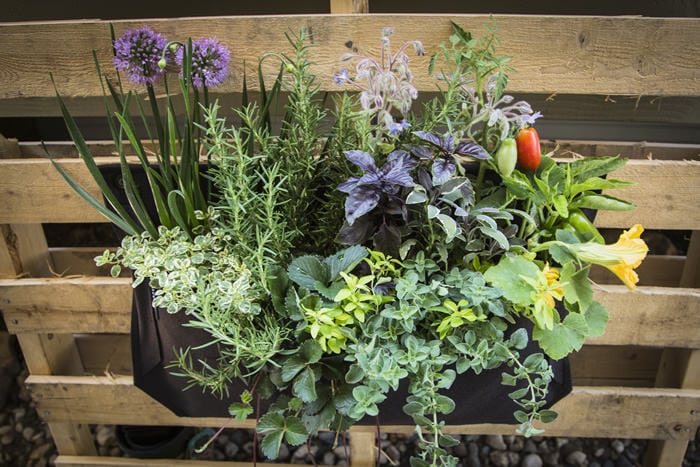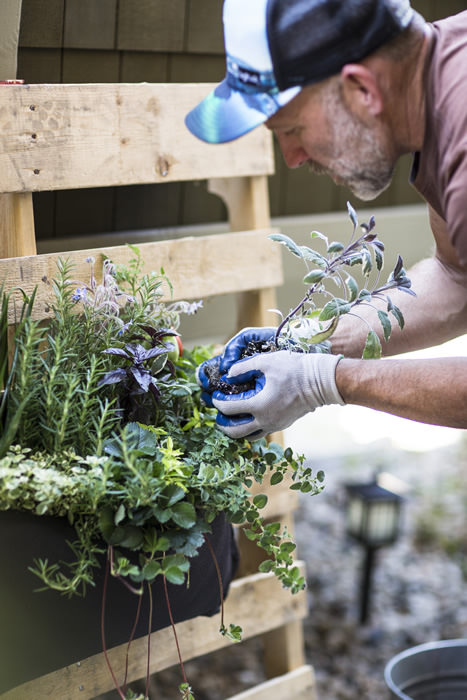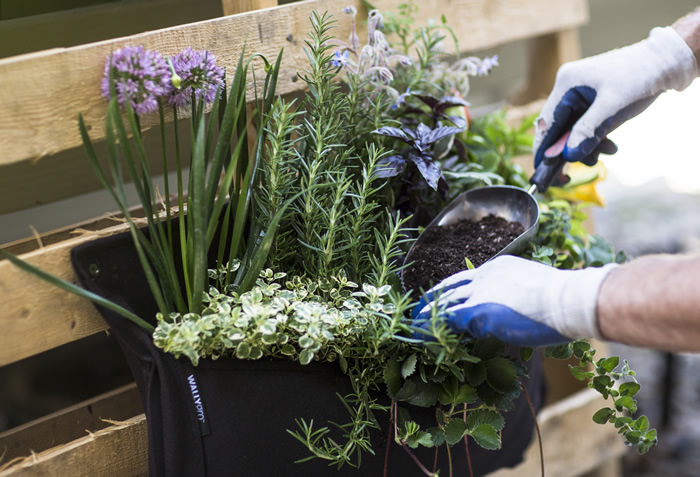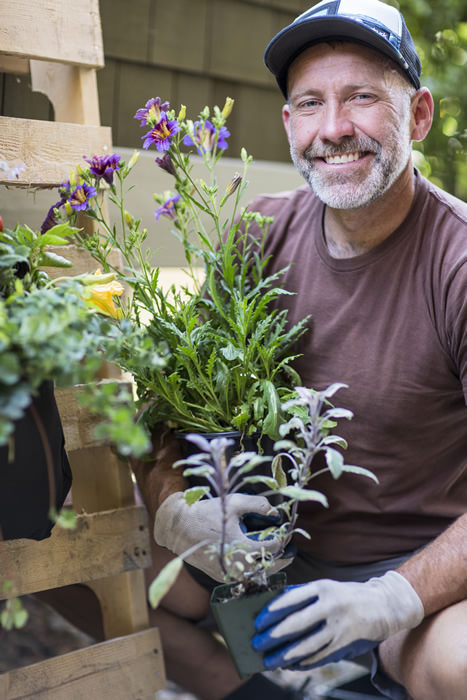Indoor edible live walls require some trial and error … and a little faith.
Cascading down like the Hanging Gardens of Babylon, vertical live walls are a popular inspiration on Instagram and Pinterest pages. While this type of garden offers various benefits, a lot more research and experimentation need to go into these mini food forests than your average garden — especially if they are planted inside.
Try, try again
When Allex LeMay-Nevis built a vertical garden in her Reno backyard from several sets of fabric planting pouches she’d purchased on Amazon, which she screwed and mounted to the side of her house, her vision was of a sea of verdant vegetables and herbs. Unfortunately, the plants were fried by the sun on that particular wall. She switched over to a mixture of ivy, jasmine, and succulents that do better in her microclimate. In turn, the leftover water from the automatically watered pouches drip into the raised vegetable beds on her patio. From the sunburned herbs and veggies, LeMay-Nevis did learn a few lessons that she would apply next time.
“I would find a way to provide more shade and to layer the plants because some plants need more water than others,” she says. “I also would love to have a hanging herb garden in my kitchen with basil, thyme, lavender, mint, or anything that you would use in a spaghetti sauce.”
For this type of handy indoor garden, the key is to experiment, learn from mistakes (most gardeners are used to this), and take some tips from the experts.
Besides the space-saving qualities, indoor, edible live walls offer additional benefits. They are adaptable to a variety of wall spaces, they’re not bothered by weeds or pests, and they can be made of self-contained products with recycled water systems, which range in price from low cost to fairly expensive. While the walls can present some challenges, they can work with some research into what will be best for your particular location and with a little help from the fast-growing cannabis industry.

Lighting challenges
“Selecting an indoor location with the right amount of light is key,” Jim Mumford says. “The cannabis industry has so much money behind it that it’s driving the lighting manufacturers to create indoor lighting for growing things you can eat.”
Mumford is a resident horticulturalist, and owner and president of Good Earth Plant Co. Inc. in San Diego. He has designed and built edible living walls for Mario Batali’s Pizzeria Mozza and Seasons 52 locations throughout California.
Mumford says that the light level in a room is measured in foot-candles. Full sun measures about 10,000 foot-candles, and edibles and flowering plants need at least 2,500 foot-candles every day for optimum production. The average kitchen gets only about 30 to 40 foot-candles.
Mumford also adds that an edible live wall is best for eating and not for show. Many of his restaurant clients have actually evolved their edible walls into ornamental walls over time with the addition of non-edible plants and flowers.
“Edibles are not that pretty, and once you start harvesting them, you’ve lost a lot of your aesthetics,” he says. “So as long as you’re planting the walls for food, you should be fine.”
Mumford has experimented with edible live walls and tried growing everything from corn to pumpkins and watermelons. He has had great luck with basil, rosemary, sage, and mint, and his top three vegetables for live walls are cherry tomatoes, peppers, and strawberries. As far as live wall products and systems, Mumford prefers a type with separate trays that easily can be removed and replanted. He also recommends that you don’t overwater and have a water catch pan that is cleaned out regularly to prevent odors.

Local help
Once you have a live wall up and running, the plants do need some special care.
“The overarching message with live walls is that you need to provide everything the plant needs to grow,” says Lisa Braginton, Moana Nursery plant doctor in Reno.
This includes appropriate soil and a little help from kelp. Plants living on an indoor live wall don’t need to defend themselves against outdoor pests and weather, so they develop a less-than-ideal cell wall. Braginton highly recommends using an organic kelp fertilizer, such as Bush Doctor Kelp Me Kelp You from FoxFarm, to strengthen the plants’ cell walls.
If you need more edible-wall guidance from a Reno designer, Nathan Brown’s company, Buds & Blooms, specializes in live walls, outdoor container gardens, floral arrangements for special events and weddings, and conceptual designs for small landscapes. Brown made a name for himself in the industry after constructing a 40-by-25-foot live wall at the Tesla Gigafactory in Storey County in less than 48 hours.

“I think live walls are the next up-and-coming thing here in Reno,” Brown says, “especially edible walls in restaurants that don’t have a lot of space. If you have a good south-facing or west-facing wall, you can install an edible live wall with a watering system and grow a large amount of food or herbs inside.”
Brown suggests that live walls be designed around a theme, such as an Italian cooking garden with oregano, parsley, and basil; an Asian garden with tatsoi, mint, and cilantro; or a spring garden with mesclun greens and kale.
“You can use anything to make a vertical garden,” Brown says. “Your imagination is the only restriction. People want to incorporate nature and greenery into their lives, and if you don’t have the space, what better way than doing it up a wall?”
Christina Nellemann is a local writer and gardener who was captivated by Nathan Brown’s Tesla project story.
Resources
Good Earth Plant Co. Inc.
Goodearthplants.com
Buds & Blooms
Budsandblooms.info
Find details about edible live wall systems and supplies at:
Wallygro.com
Livewall.com
Growediblewalls.com
Florafelt.com
Myurbio.com


